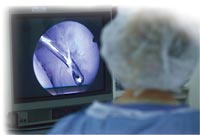Is the excitement over CAS and MIS overblown?
Some surgeons urge caution when weighing the benefits and drawbacks of computer-assisted surgery and navigation.
While computer-assisted navigation in the orthopedic operating room can provide benefits in certain cases, some surgeons still see a variety of problems with it. Computer-assisted technology adds time to operations, can introduce additional morbidities and adds another layer of complexity to an already challenging operation, some critics claim.
|
“We’re jumping in with expectations that it’s going to do something for you that it’s not. If you’re an excellent typist on a typewriter and I give you a computer, it is not going make you a better typist. And if you’re a lousy typist on a typewriter, you’re still going to be a lousy typist with the computer,” said David Hungerford, MD, of Johns Hopkins University in Baltimore. He cautioned that surgeons whose results are not particularly good may probably not improve just by adding computer navigation.
Both critics and proponents of computer-assisted surgery (CAS) agree that the use of computer navigation adds time to operations. Generally, this can be from 10 to 30 extra minutes, and Richard Scott, MD, isn’t sure that the added time is worth it.
“If there are 500,000 [total joint replacements] done in a year in the United States, and if everybody used the computer and you added 20 minutes to the operating time, you end up with 10 million extra minutes, which is 166,666 hours,” he told Orthopedics Today. “This will vary from hospital to hospital, but you could make a case for this costing $100 million or so in extra cost if everybody used it.
“Or, you could say that because of the extra time being taken, you can’t do a certain number of cases because you’ve run out of time. If you added up the hours and figured you needed 90 minutes for each case, 100,000 fewer joints would be done each year if everybody took up the time with the computer,” Scott said. “I’m obviously exaggerating it, but just trying to make the point.”
Potential complications
 Aside from the increased operative time, Scott pointed out some more specific problems with CAS.
Aside from the increased operative time, Scott pointed out some more specific problems with CAS.
“To do it right, you have to have access to [anatomic] landmarks … and with certain techniques you have to use pins to secure the terminals to the bone. And those potentially could cause morbidity with the pin holes,” Scott said. “People have reported stress fractures through the tibia when they put pins in there, and you could potentially injure nerves or blood vessels when putting them in.”
An attractive selling point
Hungerford and Scott both expressed concern over the ambitious marketing of CAS and minimally invasive procedures. The attraction of a smaller incision and faster recovery times may lead surgeons to use CAS before learning how to use it properly.
“I’m concerned about people going to a company, training for a day or two, and then coming home and presenting themselves as experts in something which is ‘new and exciting,’” Hungerford said. He also pointed out that several published studies have found increases in soft tissue and deep muscle damage with minimally invasive total hip procedures, as well as an increase in malalignment of the prostheses, when performed incorrectly.
For surgeons who are already getting good results, Hungerford said that CAS, when learned thoroughly, can make those good results even better. But he stressed that surgeons need to master conventional surgeries before adding a layer of complexity in CAS.
“It’s not a panacea for people who are not getting good results with current techniques. This is not a cure-all, it doesn’t make it simpler and it doesn’t make it quicker. It might make it better, but you’re going to have to learn how to do so.”
High expectations
Scott agreed and predicted that the enthusiasm for CAS and minimally invasive will gradually subside.
“People will still do it, but I’m going to predict that there will be an increased number of complications because of component malorientation, or possible injury to tissues or wound problems because of all the stress and tugging and pulling on the skin in order to get the instruments and the prosthesis in,” he said.
“We’ve been hyping it so much that patient expectations are going to be so high that we’re going fail to meet them in a certain number of people. I tell my patients that we’re in it for the long run, not for a few faster days of recovery. We’re in it for hopefully many years of success.”
CAS: Seeing the potential
Gaining experience with CAS instruments can help surgeons in some ways, Scott said. Surgeons can eventually learn to use shorter incisions more frequently, and pain management peri- and postoperatively will continue to improve.
For CAS to really catch on, however, companies need to improve the technology to make it more user-friendly in order to cut down the time it takes to use it, he said.
“In certain cases — for example, if someone is very obese or in patients with anatomic deformities from old injuries — then certainly the computer will help. I think if the instrument developers can simplify [the CAS technology] so that it does a couple of very essential things and shortens the time that you need to use it, then I think it will be more universally accepted,” Scott said.
Hungerford agreed: “The problem is that what people want is better, cheaper and faster, and CAS right now is maybe better but it’s more expensive, and it’s definitely slower. If CAS becomes simpler, more reliable, less expensive, and people get to the point where they can do it in either the same or even less time, then CAS will dominate.”
